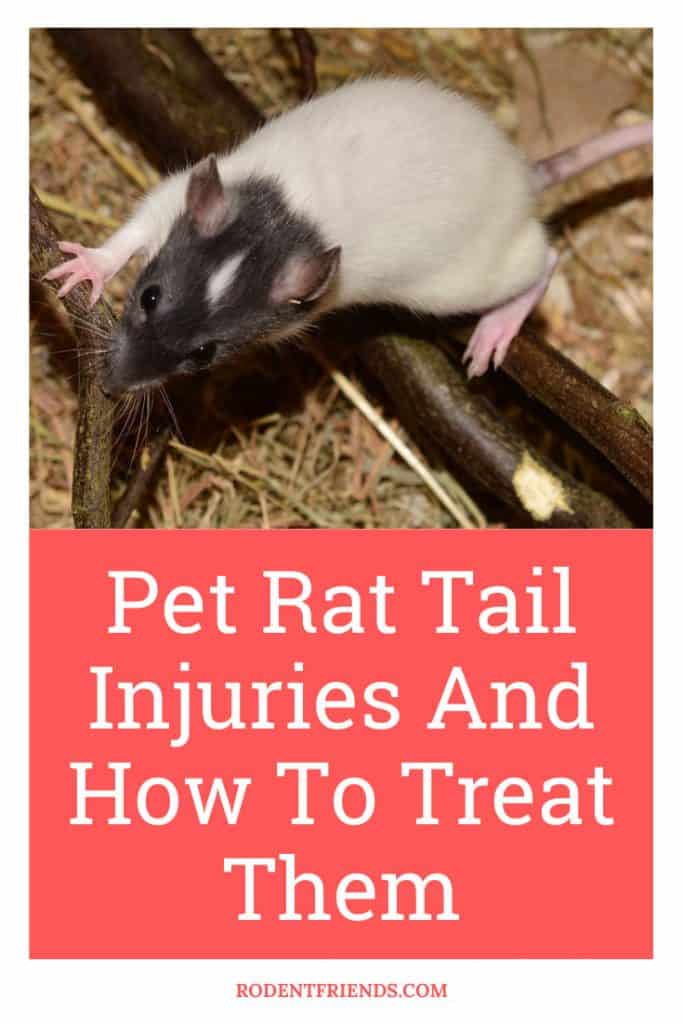Rats are excellent pets!
But due to their high energy, these tiny rodents have a tendency to fall to injuries now and then.
Even if pet rats are very clean, they can still sustain injuries.
If you have multiple rats they might lash at each other suddenly. Or they sometimes hurt themselves due to their overactive lifestyle.
The damages can be to their back, face, or even the tail!
A lot of times, you can use disinfectants to clean up the injured area and apply a suitable antibacterial cream. Then cover the injured area with a bandage to prevent infections.
However, you should always consult a veterinarian immediately as they can prescribe proper treatments and therapy to ensure adequate care for the rats.
What To Do If You Hurt Your Pet Rat’s Tail?
Pet rat tails are extremely sensitive and easy to get injuries.
They are incredibly tiny beings that can wander off somewhere and come back with an injured tail after some time.
It can be very common for them to get their tail stuck somewhere and in the panic, cause some damage!
For that reason, it’s good to be extra careful near since there’s also a chance you might injure the rat’s tail by mistake.
The initial target for these injuries would be to stop the blood loss. See if you can use something around you to control this excessive blood flow.
In the case of a small scratch, sometimes, applying gentle pressure to the injured area for a few minutes can help control the bleeding.
If this doesn’t help, the injury is probably more devastating and requires serious treatment, so a veterinarian is needed!
Small Injuries
Pet rats can often face these tail injuries because they’re constantly on the run and are very energetic, forgetting their surroundings at times.
As I mentioned before, their tails are also very sensitive. Even the slightest pull at the tail can cause the skin and flesh to come off the bone.
This is why you should never pick your pet rat by its tail and even avoid touching it as much as possible. If you need to handle your ratties, touch and grab their bodies, never their tail!
However, if something does happen, the first thing to do in this kind of situation is to control the blood flow.
If you can, wet a bit of bandage to clean the injured area. Afterward, bandage the area as best as you can, so it stops the bleeding.
Another excellent tip to help slow down blood loss is applying an ice pack. The ice will cool down the injured area and naturally slow down the blood flow.
If this is happening for the first time however and you’re unsure you can treat the injury, call a veterinarian so they can guide you and tell you what you should do!

Severe Wounds To The Tail
In case of a severe wound, the best thing to do is cover up the injured area. If the wound is kept open for a long time, there’s a chance that it can result in infection.
So first, make sure to bandage the entire injured area.
Then tighten the covering until the blood flow decreases. But do it cautiously as tightening it too much can result in further damage.
Again, keeping it too loose will cause it to slide off the rat.
Keep the injured part under constant scrutiny. See if the bandage is helping in reducing the blood flow.
If you think the dressing has done its job, you can take it off after half an hour.
But, if you notice that it’s still bleeding, reapply the bandage and immediately consult a vet.
How To Bandage a Pet Rat’s Tail
A stressed pet rat can quickly end up taking a bite from your finger or scratch in the hopes of freeing itself.
They’re not attacking you per se, they’re just scared and that’s the only way they know how to react in certain situations.
So, before applying the bandages, make sure the rat is in a calm mindset. After ensuring this, then you can start to put the dressing on.
Follow these steps, and you should be able to bandage your pet rat’s tail without any trouble:
- Find a steady, safe surface and place the pet rat on it;
- Hold them still and try to keep them calm. Giving a treat or two to keep them distracted is a good idea;
- While keeping your rattie still, pick up its tail. Be careful, as it might react to sudden movement and get out of your hand;
- Use sanitizing spray or liquid to clean up the injured area. Even if you don’t have any disinfectant, water helps clean any injury;
- Bring any antibacterial ointments that are safe for pet rats, bandages, and tapes;
- Apply a tiny amount of ointment on the tail where it got injured;
- Now, slowly cover up the area using the bandage;
- After you’re done applying the bandage, tape it firmly but not very tightly so that it doesn’t come off easily.
Again, if you or your pet rat are under too much stress, better leave this to professional hands and maybe even ask them for directions, so that if it happens again, you know what to do.
Also, be sure that whatever you’re using is safe for pet rats. It’s always good to ask your veterinarian what kind of products to keep at home in case your pet rat ever gets any injury, so you’re prepared!
Degloving In Pet Rats
Degloving occurs when a big patch of the epidermis or soft tissue just underneath it partly or separates from the rat’s body.
Even if they’re still linked to the damaged portion, this damaged skin does not get any blood.
This occurs when somebody accidentally or intentionally pulls the rat’s tail or picks it up by the tail.
A pet rat’s tail is not so strong that it can endure this much force. That’s why it comes off even at the slightest pulls.
Degloving can also happen when a pet rat tries to escape and its tail gets stuck in a particular place.
This is also why it’s important to be sure the cage you have at home is as safe as possible for your ratties.
I’ve recommended them before, but both the Prevue Hendryx and the Kaytee cages on Amazon are very safe and spacious for pet rats. When in doubt, look for at least something similar to those, both in materials and size!
These pet rat tail injuries are very painful and cause the pet rat to suffer a lot. The damage not only causes distress to the rat but also exposes it to infections.
Also, the skin and tissue surrounding the injured area do not regrow!
Common Signs Of Degloving On Pet Rats
These are some of the apparent indications that say that your pet rat is experiencing degloving:
- Flesh or skin torn from the limbs due to an injury;
- Damage on the tip or a portion of the tail due to an accident.
In short, if you notice any change, it should be looked at so it can be treated as soon as possible.

Minimal Damage
If you do notice something, the following approach may be made if the damage is modest, such as a bit of section or piece of the tail getting degloved:
- Step 1: Control all sorts of bleeding, using the same process we mentioned above;
- Step 2: Cleanse the wound with a regular antiseptic product;
- Step 3: Ensure that the injured area is dried and apply an antibacterial ointment there;
- Step 4: Afterwards put a bandage over it and cover it all around, so it doesn’t get in contact with any possible bacteria;
- Step 5: If you still find your pet rat weak and not healing, consult a veterinarian at your earliest convenience to prevent any further medical issues.
Extensive Damage
In case of severe damage where there’s been extensive blood loss, it’s really important to stop the flow.
Bandage and apply some pressure to the injury as best as you can. This is really important for too much blood loss can result in the pet rat’s death.
Keep putting pressure over the injured area while immediately contacting a veterinarian for help.
The veterinarian can determine whether the wound necessitates treatment or should it have to be removed permanently.
Will A Rat Die If It Loses Its Tail?
You might’ve seen rats without tails here and there. This shows that pet rats can live without their tails!
So if it does happen, know that they can still live a happy life.
Although it’s a vital part of their anatomy, it’s not so crucial for them that their lives are dependent on it.
Tailless rats are actually pretty common! These tiny creatures can lose their tails in many ways, actually. And since they’re so fragile, it’s not too difficult to happen.
In the wild, predators often cut off their tails completely when they engage in fights. But as it’s not a vital organ, they still live.
Pet rats without tails might be capable of surviving, but they will be more prone to mishaps.
After all, their tail is essential when it comes to balance.
So a tailless pet rat might have some more difficulty with climbing and jumping around.
However, they’ll find their way around their cage!
Moreover, rats without tails can’t shed heat like those with tails. That’s why the core temperature of those rats would be much greater as they can’t control their temperature.
Summing Up
Pet rats tend to get in trouble very often since they are so curious and want to explore every nook and cranny.
If you own a pet rat, it is important to know how to treat pet rat tail injury.
Since they’re so fragile, it’s very possible for your ratties to get an accident, and you have to be there to comfort them.
So, it’s better to acquire that knowledge beforehand and be well-prepared!
Hopefully, this article will help you know better how to care for your pet rat when they get injured.
Always be careful when treating them for they might try to fight back when under stressful situations.
Moreover, you can and should take the assistance of an expert as they’ll know exactly how to handle these situations and be safe while doing so!






1 thought on “Pet Rat Tail Injuries And How To Treat Them Quickly!”
Comments are closed.